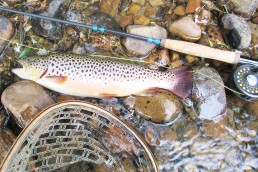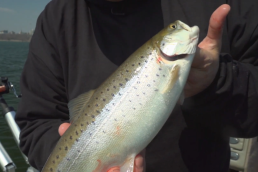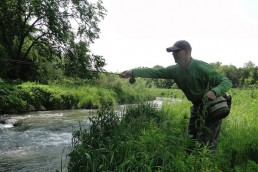Hugging Trout Behave Like Bank Robbers
SHARE THIS POST
Heavy spring rains combined with residual seasonal snow melt can rapidly pump up the water volume in a trout stream. These high-water conditions also frequently happen during summer after a torrential downpour occurs. The resulting aftermath of either event will transfer a stream that usually has a tranquil peaceful appearance into resembling a fast-moving, turbid river. These high-water conditions can make trout streams appear inhospitable for both trout and angler. In order to survive, resident trout must adapt to these difficult conditions. Any angler that desires to catch trout will have to adjust strategies in order to be successful, and these bank hugging trout behave like bank robbers.
Trout head for the sidelines
When a person looks upon a trout stream that is filled to the brim with churning water, most people would wonder how any trout could survive in these adverse conditions. In reality, trout were designed with instincts to help them cope with negatively changing water conditions. In order to survive, these fish must conserve their energy reserves, instead of depleting their strength by constantly struggling in churning, fast-flowing water. The trout seek out a section on the stream where the current speed is considerably slower than the raging water in the center portions of the stream.
Anglers realize that trout will hunker down in deep pools and put their bellies on the bottom to avoid the strong current that is above their heads. But not all streams have these deep pools, so if trout don’t have this option, where do they go?
They head for the sidelines. Comparable to a football player who is taking a break from the action on the playing field, trout are taking a break, too. Water flow speed is dramatically reduced along the edges of the streambanks, and many trout will hug the banks during high-water events.
Not out of the ball game
Even though the trout are now on the sidelines, they certainly aren’t out of the ball game. The streambanks aren’t foreign territory to trout, and most will regularly venture within these zones to feast on minnows and other sources of food harbored in this location. When trout move into the streambank water to avoid strong currents during periods of intense flows, rest assured that they haven’t lost their appetite. The trout are still hungry, and will eat. To maintain their strength in the challenging conditions of stronger current, it is a viable theory that the bank-hugging trout may actually desire to consume more food than usual.
Bank robbers and money vaults
Imagine a bank robber breaking into a bank vault that’s filled with cash, and then realizing that this bank vault also has a comfortable couch to rest on. With so much cash in front of their noses, the urge to linger is strong. That bank robber is going to sit on that comfy couch and gather up as much loot as possible.
Bank-hugging trout develop the same mentality. These trout aren’t fighting strong current in this comfortable zone of streambank, simultaneously discovering that there is plenty to eat. The trout perfectly settle into the role of a bank robber.
Fishing the streambanks
In a high-water event, trout can potentially be very close to the streambank. Considering this aspect, it is imperative to approach the streambank with stealth, because a trout may literally be right at your feet. Trout can be within a foot from the streambank, and might be holding in very shallow water. There have been occasions when I have spooked some nice trout that I did not see when I approached the streambank. Always assume that there is a trout holding next to the streambank before an approach is made, because it is quite probable that a fish is there.
Any streambank with slower-flowing water current can be productive, but super-prime streambank holding locations are the inside bank that is just downstream from a turn. The bankside current will be considerably less after this turn in the stream.
Are you enjoying this post?
You can be among the first to get the latest info on where to go, what to use and how to use it!
During high water, it is best to fish the streambank edges from upstream. Situate yourself alongside the streambank, and make short, 25- to 30-foot) casts downstream. It is not necessary to wade into the water to perform the casting.
Depending on water velocity and depth, I like to make the initial cast hit the water about 3 feet from the streambank. Let the lure, fly or bait hold in the current on a tight line for a couple minutes until making another cast. If the initial cast isn’t in the fish zone, make another cast closer to the streambank. Trout can hold in clustered groups next to the streambank, so even if you catch one, there is a good possibility that there may be more trout very close to where you connected with the initial trout. After a section of streambank is thoroughly covered with a presentation, take a few steps downstream and repeat the process.
Best bait and lures for fishing streambanks
Bank-holding trout are quite accustomed to seeing baitfish next to the streambank in high-water conditions, so don’t hesitate using small silver shiners. The flash from a 2- to 3-inch silver shiner is quite visible in shallow water, and simply irresistible to ring the diner bell for any nearby trout. Hook the shiner through the head section to give it a natural downstream presentation. Worms are equally effective when hooked through the head section and held in the current with a downstream presentation.
Water depth will be shallow and current velocity will be slower alongside the streambank, so either use no weight, or perhaps a single small BB-size split shot for weight. The goal is to submerge the bait just underneath the water’s surface in the shallow water. Too much weight will result in frequent bottom snags.
There are plenty of effective spinning rod lures on the market, but a few really stand out for being effective. A small, shallow-diving Rapala is deadly. This time-proven lure is available in a multitude of sizes and colors; choose the color and size that mimics the minnows within your favorite stream. Other good spinning lure choices are small Mepps or Blue Fox spinners. The blades turn easily on these lures when held in current, and are tantalizing for the trout. With the shallow water alongside the streambank, remember to go small and light to avoid bottom snags.
Fly anglers will have good results with silver-bodies streamers or wooly buggers. Good color choices for wooly buggers are grey, brown or black. Underwater stream-born insects will also be present alongside the streambanks and are a good option. Small prince nymphs or hares ear nymphs are good fly pattern choices. No matter what the choice, use lightweight fly patterns to avoid snagging on the bottom.
If you are fishing an unfamiliar stream, don’t hesitate to stop in a local fishing shop to ask for advice on bait, lure and fly pattern selections. Fishing shops have a good knowledge base about their local waters, and advice from these sources can be truly priceless.
Target streambanks during high water!
When high water occurs during this fishing season, be absolutely sure to target streambanks in trout streams. The fishing action will be great for bank-robbing trout, and your fishing rod will get a good workout by the end of the day.
Become a MidWest Outdoors Insider here!
MWO
SHARE THIS POST
Did you enjoy this post?
You can be among the first to get the latest info on where to go, what to use and how to use it!
John Murray
John Murray has a passion for the outdoors. A former professional fly tyer and fishing shop owner for more than a decade, John is a member of the NYS Outdoor Writers Association and is determined to share an acquired lifetime of knowledge to help everyone become proficient hunters and anglers.



